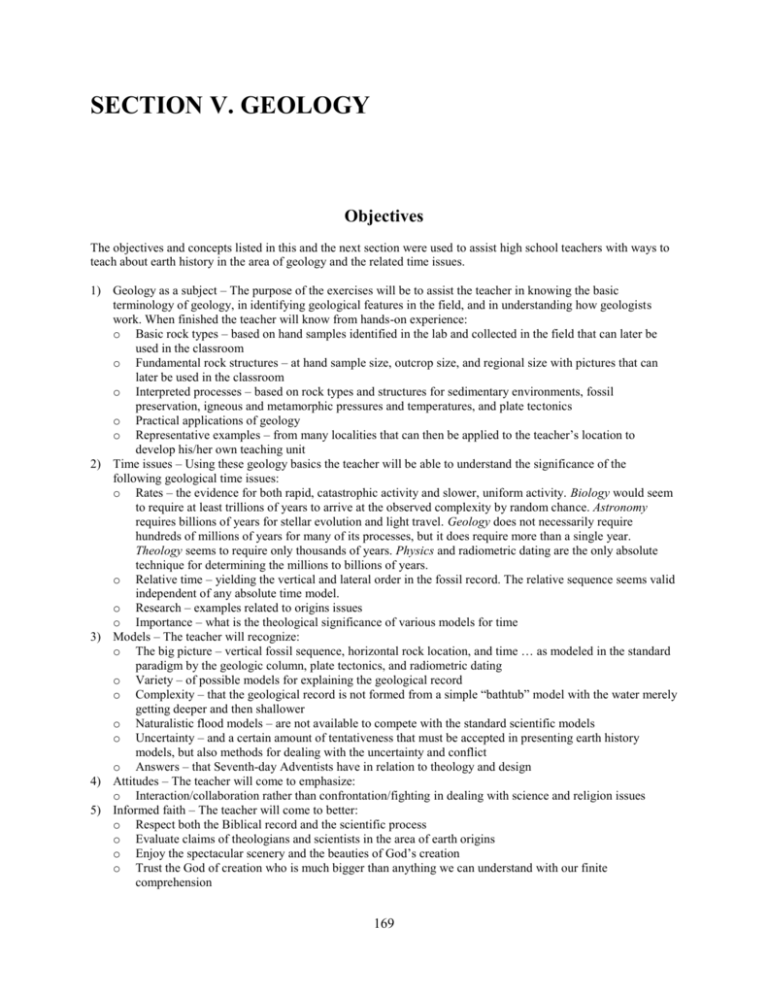geology intro
advertisement

SECTION V. GEOLOGY Objectives The objectives and concepts listed in this and the next section were used to assist high school teachers with ways to teach about earth history in the area of geology and the related time issues. 1) Geology as a subject – The purpose of the exercises will be to assist the teacher in knowing the basic terminology of geology, in identifying geological features in the field, and in understanding how geologists work. When finished the teacher will know from hands-on experience: o Basic rock types – based on hand samples identified in the lab and collected in the field that can later be used in the classroom o Fundamental rock structures – at hand sample size, outcrop size, and regional size with pictures that can later be used in the classroom o Interpreted processes – based on rock types and structures for sedimentary environments, fossil preservation, igneous and metamorphic pressures and temperatures, and plate tectonics o Practical applications of geology o Representative examples – from many localities that can then be applied to the teacher’s location to develop his/her own teaching unit 2) Time issues – Using these geology basics the teacher will be able to understand the significance of the following geological time issues: o Rates – the evidence for both rapid, catastrophic activity and slower, uniform activity. Biology would seem to require at least trillions of years to arrive at the observed complexity by random chance. Astronomy requires billions of years for stellar evolution and light travel. Geology does not necessarily require hundreds of millions of years for many of its processes, but it does require more than a single year. Theology seems to require only thousands of years. Physics and radiometric dating are the only absolute technique for determining the millions to billions of years. o Relative time – yielding the vertical and lateral order in the fossil record. The relative sequence seems valid independent of any absolute time model. o Research – examples related to origins issues o Importance – what is the theological significance of various models for time 3) Models – The teacher will recognize: o The big picture – vertical fossil sequence, horizontal rock location, and time … as modeled in the standard paradigm by the geologic column, plate tectonics, and radiometric dating o Variety – of possible models for explaining the geological record o Complexity – that the geological record is not formed from a simple “bathtub” model with the water merely getting deeper and then shallower o Naturalistic flood models – are not available to compete with the standard scientific models o Uncertainty – and a certain amount of tentativeness that must be accepted in presenting earth history models, but also methods for dealing with the uncertainty and conflict o Answers – that Seventh-day Adventists have in relation to theology and design 4) Attitudes – The teacher will come to emphasize: o Interaction/collaboration rather than confrontation/fighting in dealing with science and religion issues 5) Informed faith – The teacher will come to better: o Respect both the Biblical record and the scientific process o Evaluate claims of theologians and scientists in the area of earth origins o Enjoy the spectacular scenery and the beauties of God’s creation o Trust the God of creation who is much bigger than anything we can understand with our finite comprehension 169 Geological Concepts Rock Types Sedimentary – rocks deposited by water or wind Clastic: conglomerate LOCATIONS: Spectacular conglomerates can be found in the Cadomin Fm and in the gritstone of the Miette near Lake Louise and Jasper. ORIGINS SIGNIFICANCE: Conglomerate deposits made up of pebbles required rapidly moving water to transport them. Higher energy deposition can be said to be more catastrophic. Clasts (rock pieces) in the conglomerate are the best indicators of provenance before deposition (i.e., source). Clastic: sandstone LOCATIONS: Sandstone can be found in some of the Mesozoic formations, such as the Brazeau, Kootenay, and Fernie. ORIGINS SIGNIFICANCE: Sandstone is made up of sand grains that were deposited in an intermediate energy environment such as near-shore marine, or terrestrial streams. PRACTICAL SIGNIFICANCE: Sand is used for making glass. Sand and gravel are generally the most economically valuable mining material in any locality. Clastic: shale LOCATIONS: Shale can be found in some of the Mesozoic formations, such as the Brazeau, Kootenay, and Fernie. ORIGINS SIGNIFICANCE: Shale is formed from clay deposited in a low energy environment. Sometimes clay can be precipitated rapidly, but is usually considered to be deposited slowly from quiet water in a marine or lake environment. PRACTICAL SIGNIFICANCE: Clay is mined for use in making ceramics. Kaolinite clay is thought to be of continental origin and the result of diagenetic (post-depositional) alteration. Shale that weathers to bentonite clay can cause heaving foundations and roads. Clay must be compacted to shale by up to 70% before it can form a seal for a petroleum reservoir. Chemical: limestone LOCATIONS: Much of the Paleozoic is limestone, including the Devonian Fairholme reef. ORIGINS SIGNIFICANCE: Massive limestone is usually interpreted as formed in a marine environment from the breakdown and recrystallization of calcium carbonate structures of living organisms such as shells, corals, and many other simpler organisms. This would seem to take time. Limestone is easily dissolved by moving ground water leaving behind underground caves and surface karst topography. The calcium carbonate can then precipitate out in caves as speleothems (cave formations). Again, the question of time for dissolution and precipitation is an issue. Both ancient and modern limestone reefs would require time for formation by living organisms. PRACTICAL SIGNIFICANCE: Limestone is quarried for making cement. Oil exploration often finds that reefs can be good traps for oil. Limestone is used as a building material, e.g., all the buildings in Jerusalem. Chemical: evaporites – gypsum LOCATIONS: Gypsum can be found in some Mississippian Golden Embayment rocks south of Banff N.P. ORIGINS SIGNIFICANCE: Evaporite deposits are usually interpreted to form from evaporation of sea water in hot, dry conditions, but can also form underwater from brines. The purity of evaporites is hard to model. The formation of gypsum requires huge amounts of the sulfate ion (SO 42-). PRACTICAL SIGNIFICANCE: Gypsum is mined, e.g., for wall board (sheet rock). 170 Organic: coal, oil LOCATIONS: Major oil and gas reserves are found in the Devonian Fairholme and the Cardium Fms. Coal is mined from the Kootenay Group. Coal continues to burn in mines in the Crowsnest Pass area south of Banff. ORIGINS SIGNIFICANCE: Oil is usually considered to come mostly from algae deposited slowly on the ocean floor. Coal is explained as coming from plant material growing in swamp areas. The purity of coal is hard to model. The book Patriarch and Prophets refers to underground burning coal seams. PRACTICAL SIGNIFICANCE: Oil and coal (and associated natural gas) are currently the world’s major energy sources, currently greater than 60% for Southern California Edison. Igneous – rocks formed from magma or lava Intrusive: granitic type rock formed by slow cooling of magma underground LOCATIONS: Large areas in British Columbia, but only seen on this excursion at Crowfoot Dyke. ORIGINS SIGNIFICANCE: It takes a significant amount of time for large igneous intrusions (batholiths) to cool from a magma. Extrusive: volcanic rock formed by rapid cooling of lava above ground LOCATIONS: Volcanic ash from Mt Mazama can be seen at the Saskatchewan River Crossing ORIGINS SIGNIFICANCE: Volcanos exemplify the typical geological catastrophe. PRACTICAL SIGNIFICANCE: Volcanoes are a significant geological hazard that can be mitigated by proper monitoring to warn of eruptions. Mining LOCATIONS: Lead and zinc were mined near Kicking Horse Pass in the area of Field, BC. ORIGINS SIGNIFICANCE: Gold and precious stones were readily available before the flood, but now difficult to find. (PP90,108) PRACTICAL SIGNIFICANCE: Most mineral resources come from igneous rock. Geothermal LOCATIONS: Hot springs at Banff and Radium Hot Springs ORIGINS SIGNIFICANCE: Rate of heat flow is a significant time issue. PRACTICAL SIGNIFICANCE: Geothermal energy is a significant untapped energy resource, currently 9% for Southern California Edison, up from 4% in 2005. Metamorphic – rocks changed by high pressure and/or temperature Slate, schist [shiny micaceous surfaces], and gneiss [light/dark bands] – formed from shale type rocks LOCATIONS: The Miette Grp near Lake Louise contains slate. ORIGINS SIGNIFICANCE: Apparently requires time for a cycle of sediment deposition, deep burial for elevated pressures and temperatures, exhumation (removal of overlying rock), and erosion to see present outcrops. The formation of large crystals is assumed to require time, but is also aided by significant water content in the rock. PRACTICAL SIGNIFICANCE: Beautiful and exotic gem quality mineral specimens are often found in metamorphic rocks. Quartzite – formed from sandstone LOCATIONS: Gog quartzite near Snowbird Glacier and Mt Wilson Fm near Saskatchewan River Crossing. ORIGINS SIGNIFICANCE: Pure quartzites seem to requires several cycles of deposition and erosion that would take time -- formation of the original rock, erosion, transport, deposition of the second formation, lithification, uplift, and erosion to see the current outcrop. Marble – formed from limestone LOCATIONS: In Marble Canyon along the road toward Radium Hot Springs ORIGINS SIGNIFICANCE: Apparently requires time for limestone deposition, burial, intrusion of magma to elevate temperatures of the limestone, and exhumation (removal of overlying rock). PRACTICAL SIGNIFICANCE: Quarried for building stone and sculptures. 171 Geologic Processes Water movement Flooding LOCATIONS: The Cadomin conglomerate suggests deposition by flash flooding. ORIGINS SIGNIFICANCE: The catastrophic effects of rapidly moving water are often forgotten until it is too late. PRACTICAL SIGNIFICANCE: Dams, reservoirs, and weather forecasting are used to try to mitigate flood hazards. Erosion/weathering LOCATIONS: Examples of erosion can be seen in many places, but Johnston Canyon is spectacular. ORIGINS SIGNIFICANCE: Present-day rates of river erosion world-wide would remove the continents in much less than a billion years. Chemical weathering of granitic rock takes time to turn it to clay. Stream meanders require slow moving water. Rapidly moving water forms a straighter riverbed. How can entrenched meanders form quickly? PRACTICAL SIGNIFICANCE: Rapid erosion causes rapid loss of the fertile top soils to the oceans. Sedimentation Turbidites LOCATIONS: Mega-turbidites in the Miette Grp west of the town of Jasper and turbidites in the Fernie Fm near the town of Banff. ORIGINS SIGNIFICANCE: Turbidites are rapidly deposited sedimentary layers. Some flood geologists have used turbidite deposits to explain how thick sequences of sedimentary material can be deposited in a relatively short period of time. PRACTICAL SIGNIFICANCE: Turbidity currents that deposited turbidites were responsible for the breaking of multiple trans-Atlantic cables on the Grand Banks off Nova Scotia in 1929. Cross bedding LOCATIONS: In the Gog quartzite north of the Icefields Center ORIGINS SIGNIFICANCE: Cross bedding is interpreted as often coming from dune deposits, either underwater or in desert dunes. Desert dunes could be difficult to fit into the middle of a world-wide flood. Terrestrial geologic processes, i.e., not by water Glaciation LOCATIONS: Evidence of continental glaciation such as U-shaped valleys, moraines, glacial erratics, roches moutonnée, and striations can be seen throughout the Banff and Jasper N.P. area. ORIGINS SIGNIFICANCE: How much time is required for Pleistocene glaciation, considering the number of layers in the ice cores? How does one explain evidence for glaciation, such as striations and erratics, in the middle of the geologic record? PRACTICAL SIGNIFICANCE: Ice cores are studied in an effort to understand global warming. Landslides LOCATIONS: Along the main road through Banff N.P. ORIGINS SIGNIFICANCE: Landslide striations have been used as an alternative explanation to glacial striations. Landslides exemplify a typical geological catastrophe. PRACTICAL SIGNIFICANCE: Landslides and soil creep cause more monetary damage to property than any other hazard, but it can be mitigated by proper building regulations. Soil formation LOCATIONS: Paleosols in the Rundle Grp near Canmore and in the Ranger Cyn Fm northeast of Saskatchewan River Crossing. 172 ORIGINS SIGNIFICANCE: Soil horizons take longer than a year to form, but the evidence for soil horizons in the geologic record may be equivocal. PRACTICAL SIGNIFICANCE: Once a fertile soil horizon is destroyed by erosion of poorly cultivated land, it is a difficult process to redevelop fertile land. Extraterrestrial impacts LOCATIONS: One explanation the geological community gives for the mass mortality at the CretaceousTertiary (K-T) boundary is an extraterrestrial impact in the area of the Yucatan Peninsula resulting in a world-wide iridium anomaly at this horizon. The K-T boundary occurs in the Willow Creek Fm south of Banff. ORIGINS SIGNIFICANCE: An extraterrestrial impact with an accompanying mass extinction exemplifies the typical geological catastrophe. PRACTICAL SIGNIFICANCE: Attempts have been made to monitor potentially dangerous meteors in regions close to earth’s orbit. It has been suggested that correctly setting a nuclear explosion on one might deflect its path away from collision with the earth. Tectonics – earth movements Plate tectonics LOCATIONS: The mountain building (orogeny) of the Precambrian and of the present Rocky Mountains are explained by plate tectonic compression. ORIGINS SIGNIFICANCE: How are the movements of the continental plates explained in a short time frame? PRACTICAL SIGNIFICANCE: Plate tectonics is the greatest unifying concept in physical geology. All of the following tectonic features are explained in terms of plate tectonics. Folding LOCATIONS: Large synclines can be seen in several places along the Icefields Parkway. An especially noticeable syncline can be seen on Cascade Mtn near Banff. ORIGINS SIGNIFICANCE: Mountain building (orogeny) and other tectonic movements are high energy processes. Folding can be due to slow movement and plastic deformation or more rapid movement of poorly lithified sediments. PRACTICAL SIGNIFICANCE: Shale folded into an anticline can act as an oil and gas trap. Faulting, including thrust faults LOCATIONS: Numerous thrust faults can be observed throughout the Canadian Rocky Mtns. ORIGINS SIGNIFICANCE: Thrust faulting requires enormous amounts of energy. Faulting is brittle deformation and generally assumed to be due to relatively abrupt movement. Earthquakes LOCATIONS: It is assumed that earthquakes are the result of any sudden motion along faults, especially the many thrust faults in the Banff area ORIGINS SIGNIFICANCE: Earthquakes exemplify the typical geological catastrophe. PRACTICAL SIGNIFICANCE: Earthquakes are a significant geological hazard that can only partially be mitigated by proper building codes in areas where recent earthquakes are known to have occurred. Paleontology Fossilization processes LOCATIONS: Tyrrell Museum displays. ORIGINS SIGNIFICANCE: Fossilization generally requires rapid burial. PRACTICAL SIGNIFICANCE: Some level of organic preservation is necessary for coal and oil formation. Mass extinctions/mortalities, lagerstätten – good preservation LOCATIONS: Tyrrell Museum displays ORIGINS SIGNIFICANCE: Good preservation probably requires some kind of catastrophic action. 173 Dinosaurs LOCATIONS: Royal Tyrrell Museum ORIGINS SIGNIFICANCE: Dinosaurs did really exist. How does one explain their distribution in the geologic column? Were they God’s creation or just the result of sin? Fossil sequence – trends, patterns LOCATIONS: We will walk through the fossil sequence of the geologic column at the Royal Tyrrell Museum. ORIGINS SIGNIFICANCE: The order suggests some kind of evolutionary sequence. PRACTICAL SIGNIFICANCE: The fossil sequence is used in exploration for natural resources to determine the location in the geologic column. Ecological life zones LOCATIONS: various life zones can be observed at different elevations in the parks. ORIGINS SIGNIFICANCE: Ecological zonation theory is part of the creationist explanation for the order in the fossil record. Overall Rock/Fossil Sequence LOCATIONS: Rock layers from most periods of the geologic column will be visible in sequence at several areas. ORIGINS SIGNIFICANCE: The sequence in the geologic column appears to be real, not just an artificial construct. PRACTICAL SIGNIFICANCE: The rock sequence is used in exploration for natural resources. Wide-spread deposits LOCATIONS: Several of the formations in Banff cover wide areas. ORIGINS SIGNIFICANCE: These and other wide-spread deposits have been used as evidence for a widespread flood. Unconformities – angular LOCATIONS: A slight angular unconformity can be seen between the Gog Grp and the Miette Grp at the southern end of the Icefields Parkway ORIGINS SIGNIFICANCE: Angular unconformities indicate the passage of time for deposition of the lower sediments, their burial and lithification, angular uplift, erosion, then deposition of the upper sediments, lithification, and erosion. This was the convincing evidence of time for James Hutton at Siccar Point in Scotland. Unconformities – paraconformity LOCATIONS: The Silurian gap can be seen in a roadcut north of the town of Jasper. ORIGINS SIGNIFICANCE: Based on the fossil record, millions to tens of millions of years appear to be missing, but looking at the contacts often shows no evidence of long times of non-deposition and erosion. Radiometric dating LOCATIONS: Few igneous rocks can be seen in our field areas, but the volcanic ash from Mt Mazama found at Saskatchewan River Crossing could be radiometrically dates. ORIGINS SIGNIFICANCE: The radioactive parent-daughter ratios of various isotopes indicate millions of years of radioactive decay. 174








